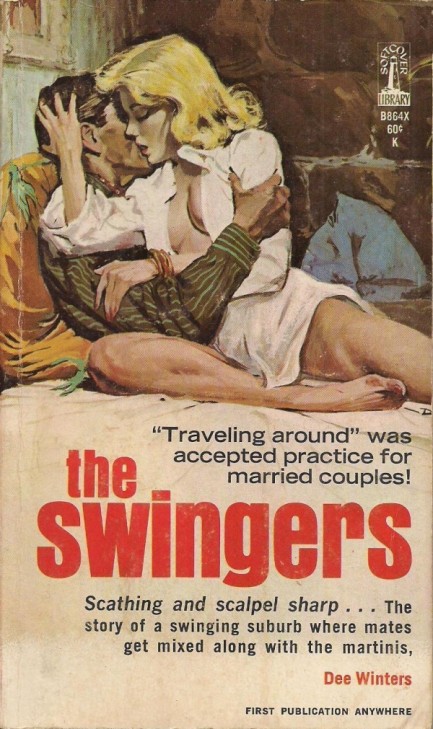 I want to remember everything about this experience. For starters tell me your name. 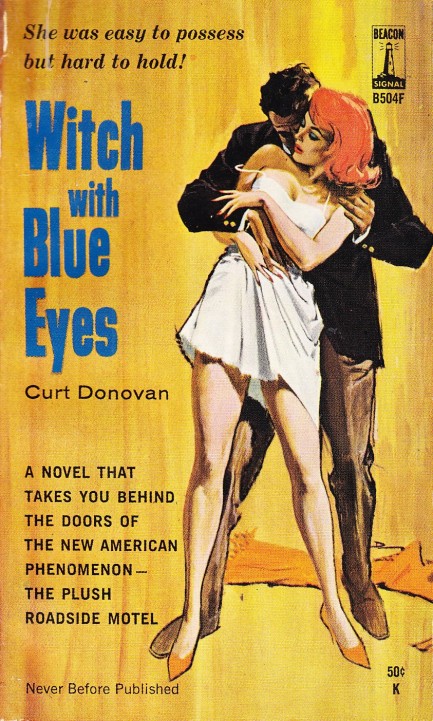
The 1962 novel Witch with Blue Eyes, which you see here with its Ernest Chiriacka cover art, is about a man who quits a big hotel operation, hires on as manager of the Snug Haven roadside motel, but must battle two craven partners in order to turn it from a shady dive into a respectable success. The hours and stress test his marriage to the owner's daughter, and problems worsen when his former lover—the eponymous witch with blue eyes—arrives on the scene (accompanied by her evil cat Big Bad) to ruin him. The book was presented by publishers Beacon-Signal as sleaze, but it's virtually sexless, and as a pure drama it's flatter than a flapjack. We suggest you don't check in to this motel.
 No man who dumps her ever lives to regret it. 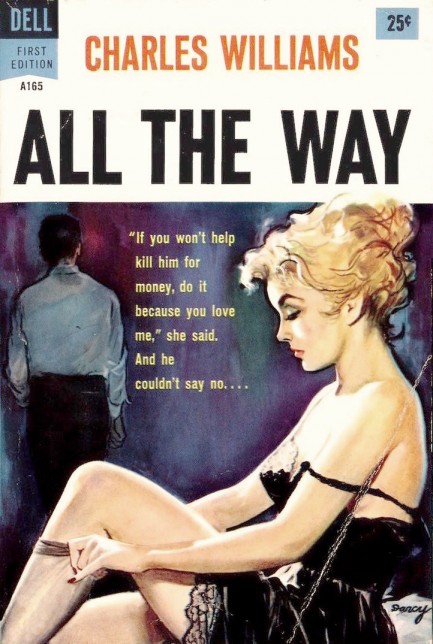
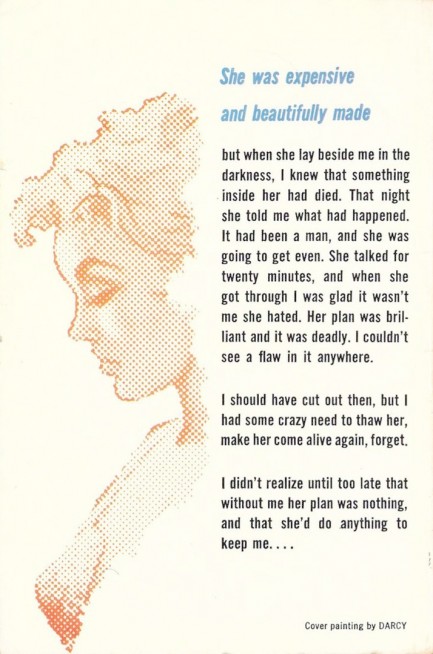 One day there will be no more Charles Williams for us to read, and that'll be sad, but his books, like good wine, are something you have to treat yourself to regularly even as the stock dwindles. His 1958 novel All the Way, which is the source material for the 1960 movie The 3rd Voice, is typically solid Williams work. One day there will be no more Charles Williams for us to read, and that'll be sad, but his books, like good wine, are something you have to treat yourself to regularly even as the stock dwindles. His 1958 novel All the Way, which is the source material for the 1960 movie The 3rd Voice, is typically solid Williams work.
It has a fascinating plot at its center. A vengeful woman enlists a fugitive to help her steal her former lover's identity, then impersonate him for weeks afterward so nobody will suspect when he disappears that she's actually killed him. The reason people are supposed to assume a disappearance instead of murder has to do with paranoid schizophrenia in the ex-lover's family, and the fact that the fugitive impersonating him has been faking its rapid onset, publicly and loudly.
With the ground laid in this way, a disappearance will be the logical conclusion, and since the man is rich, the fact that a hundred seventy grand is missing from his bank accounts merely indicates he's never coming back—not that an imposter has withdrawn the cash. The scheme is convoluted, but the genius femmes who come up with them are a staple of pulp literature. Williams gets the job done again, as does Ernest Chiriacka, who painted the cover art.
 Whew! I'm getting tired. But there you have it—the letter Y. Next up is my finale—the letter Z! 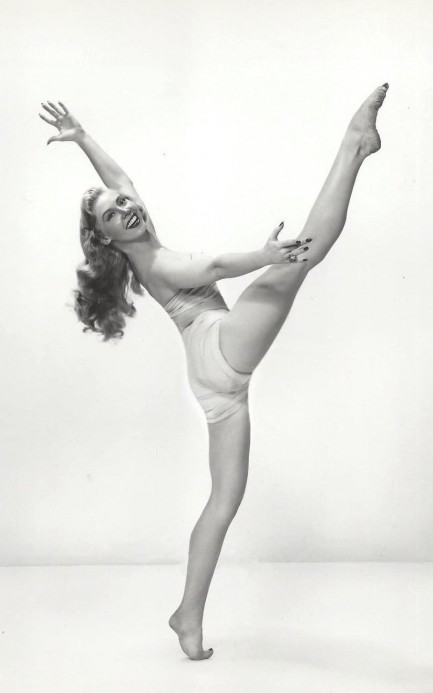
Georgine Darcy shows her dancing flexibility in this promo image made in 1954, around the time she was making her debut in Rear Window. She appeared in a few other films, among them Women and Bloody Terror, and guested on about a dozen television shows—Mike Hammer and Peter Gunn come to mind—but she'll probably always be remembered as Miss Torso from Hitchcock's classic. The only thing is, they should have called her character Miss Everything, because she's got it all.
 For every job there's a perfect tool. 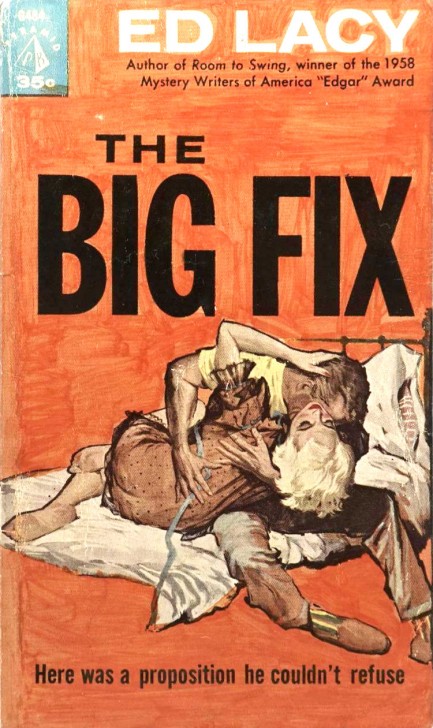
In Ed Lacy's 1961 boxing drama The Big Fix, the fix is defnitely in, and in the worst way possible. Tommy Cork, a thirty-something middleweight boxer who in his prime battled Sugar Ray Robinson, becomes the pet project of a dilletante boxing manager who promises that with the best training, diet, and promotion Cork can reach the top again. Sounds good, but Tommy has unwittingly become the focus of a deadly scam, a plan to find some desperate boxer with a reputation for ugly losses, make a show of training him for high profile bouts, all the while taking out a life insurance policy on him, then having a hammerfisted accomplice kill him in the ring. Since the murder will happen before a crowd, there will be no suspicion of foul play, particularly for a pug known for fighting stubbornly and hitting the canvas hard.
But nothing is straightforward in Lacy's hands. Tommy's wife May, hopeful for a better life, gets into trouble with violent numbers runners, an aspiring writer sees the couple as the perfect pathetic characters to be the focus of a novel, an ex-boxer cop starts to get wise to the murder scheme, and other twists come from nowhere to infinitely complicate the tale. Despite the subplots, as readers you know the only fitting climax is one that takes place in the ring, and Lacy pushes the story inexorably toward that showdown, hapless Tommy facing off against a man who plans to kill him with a relentless assault, or if possible a single blow. If he's going to have help, he'll need to provide it himself. As usual, Lacy tells a good story. He's reliably full of excellent ideas. That also goes for Ernest Chiriacka, who painted the eye-catching cover.
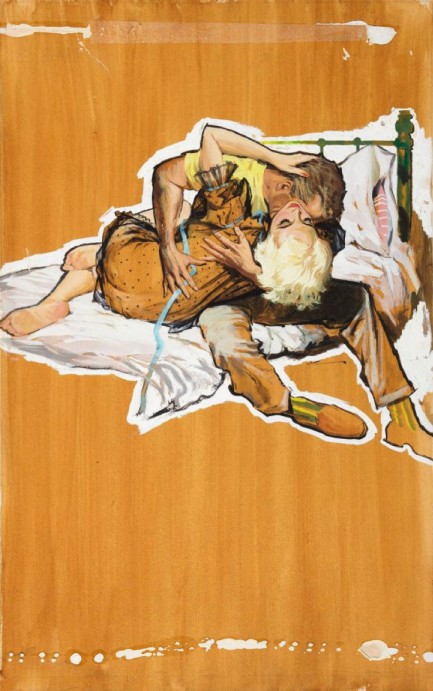
 Is sex déjà-vu a thing? Because I feel like we've lived this before. Try not to finish so fast this time. 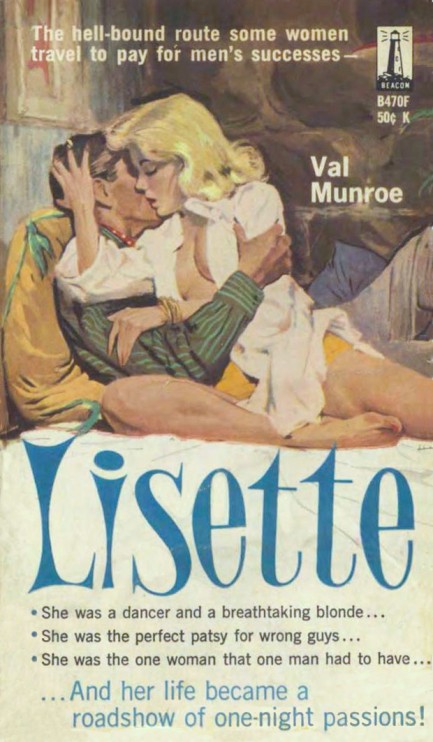
Above: a cover for Val Munroe's Lisette, painted by Darcy, aka Ernest Chiriacka for Beacon Signal, 1962. We were surprised when we discovered this was Munroe's Carnival of Passion under a different title. Since the name of the main character is Lisette rather than Liz, we didn't guess it was the same book, and you'll also notice the cover doesn't mention a carnival. Luckily we didn't pay for this because it was available for download on Archive.org. By the way, the story wasn't the only thing repeated here. The art was later paired with Dee Winters' 1965 sleazer The Swingers, as you see below.
 Formal occasions in Mogadishu are murder. 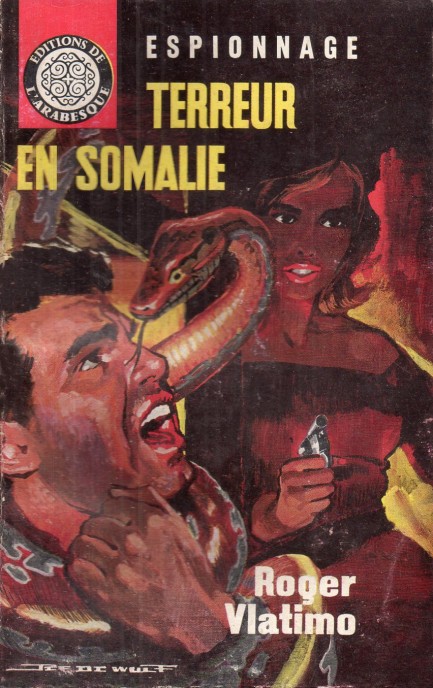
Jef de Wulf works in a somewhat different mode with this cover illustration for Roger Vlatimo's, née Roger Vilatimo's 1963 spy novel Terreur en Somalie. His art is usually quite spare, often with a lot of negative space, but here he's produced something chaotic that fills the frame and draws the eye to various elements—gun, lipstick, a splash of color that gives the impression of flames, and of course the snake. The contrast with his work at its cleanest is stark. Look here or here to see what we mean.
Vlatimo wrote a stack of spy capers set in exotic places like Morocco, Iran, Turkey, and Vietnam. He also wrote a series as Youcef Khader, and those all starred a franchise character, Algerian special agent Mourad Saber. Additionally, Vlatimo wrote as Jean Lafay, Tim Oger, Roger Vlim, and Gil Darcy, which was a pseudonym invented by Georges J. Arnaud and used by several authors. Vlatimo's books were quite popular and some are even available today as e-books, which is the surest sign of success we can imagine. Vlatimo, though, died back in 1980.
 Okay... love you too... too tight... need to breathe now... 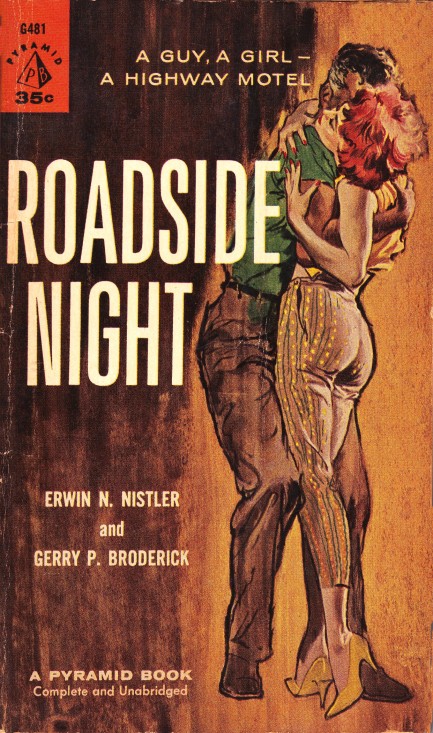
This is a classic cover from highly respected paperback artist Ernest Chiriacka, aka Darcy, one of his very best. He specialized in couples. Embracing couples, smooching couples, angry couples, pensive couples, but in most cases his work has the same sort of feel you see above. We've put together a collection to show you in a bit. In the meantime, let this excellent example whet your appetite, and remember—if you love somebody set them free.
 Headquarters, my gas mask has failed! I'm throwing a grenade! How the hell does this thing work? Over! 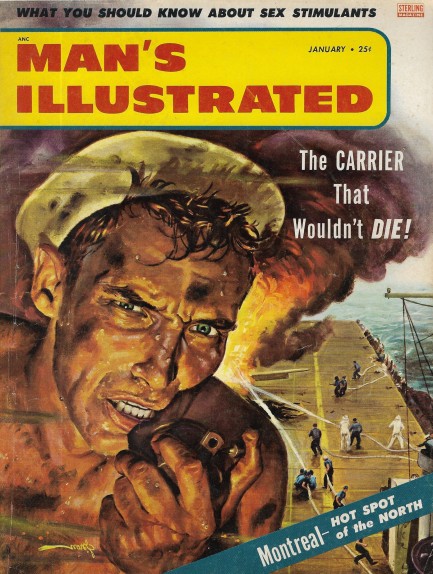
George Gross art fronts this January 1956 issue of Hanro Corp's bi-monthy magazine Man's Illustrated. It's an interesting image, but here's where we show our age, or lack of industrial background, or something, because we have no idea what the hell Mr. Flinty Eyes on the cover is holding. Hand grenade? Gas mask? Some kind of steampunk style microphone? Combo of all three? Well, not knowing is not a problem. We still like the image.
It's been a while since we featured this magazine, but we're glad to get back to it because inside this issue there's art from Walter Popp and Rudolph Belarski, and a nice feature on Rear Window actress Georgine Darcy, who we've talked about once or twice before. As far as written content, you get plenty of war and hunting action, of course, but we were drawn to, “The Hottest Town North of the Border,” an investigative piece by journo B.W. Von Block. What town is he talking about? Montreal, which apparently back in ’56 was the one of the best places in the world to get your ashes hauled.
These type of stories, which were standard in old men's magazines, always give us a laugh because with their breathless focus on subjects like legal prostitution, nude beaches, and dusk-to-dawn nightclubs they show how repressed the U.S. was compared to so much of the world. It still is, actually. Trust us, we've been around, lived abroad for a long time now, and greatly enjoyed the more permissive societies in which we've resided—including our current one.
The U.S. does have many good points, though, one of which is that no country's inhabitants preserve its popular media so prodigiously—which is why we have so many vintage books and magazines to share on Pulp Intl. in the first place. We've pondered many times why Americans hoard more than other cultures and we've finally come up with an answer: garages. Two thirds of Americans have garages. So here's to American garages. They give millions the joy of being their own museum curators.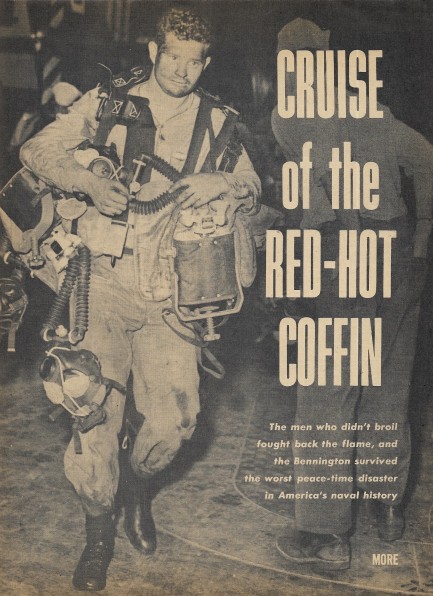 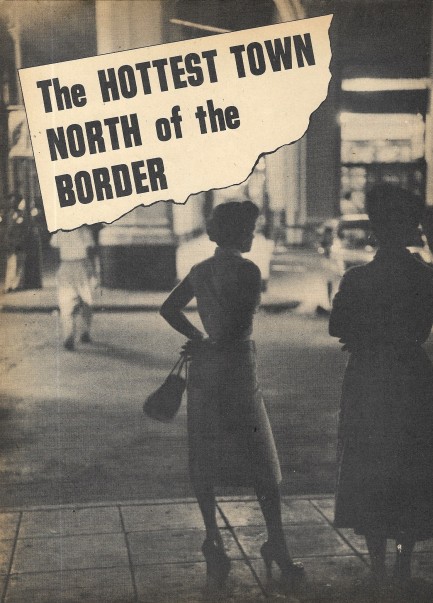 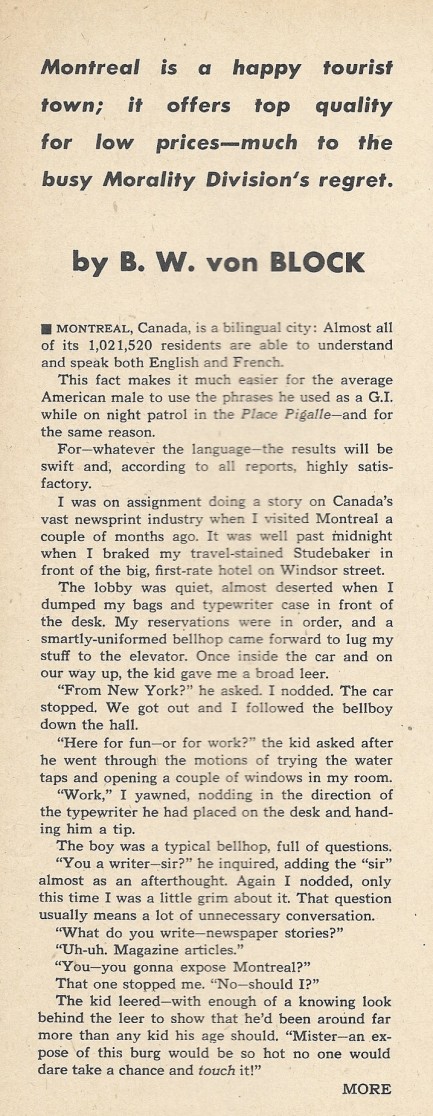 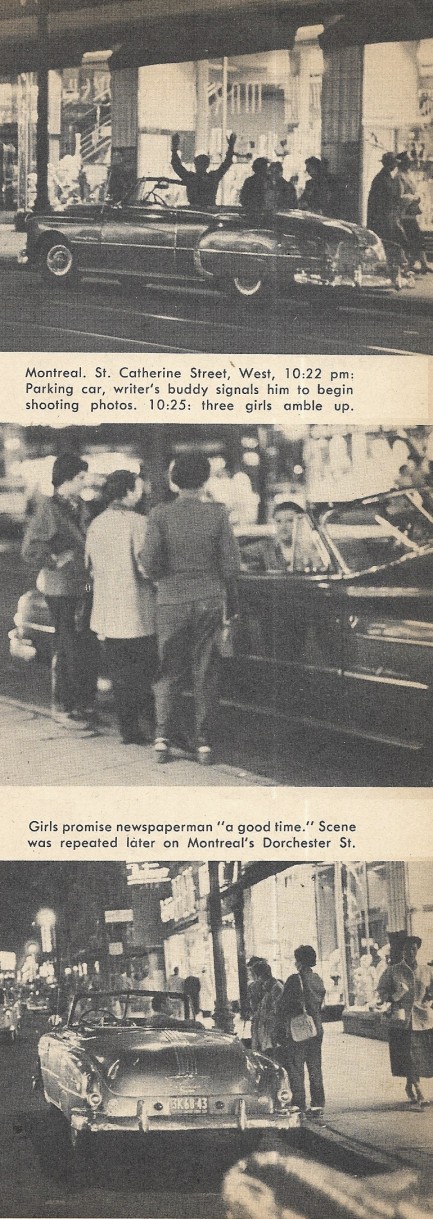 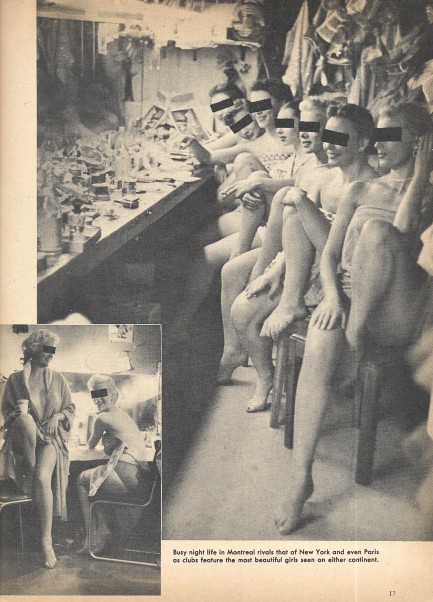 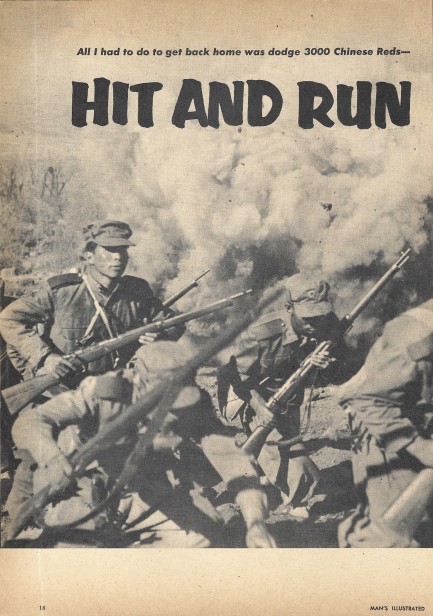 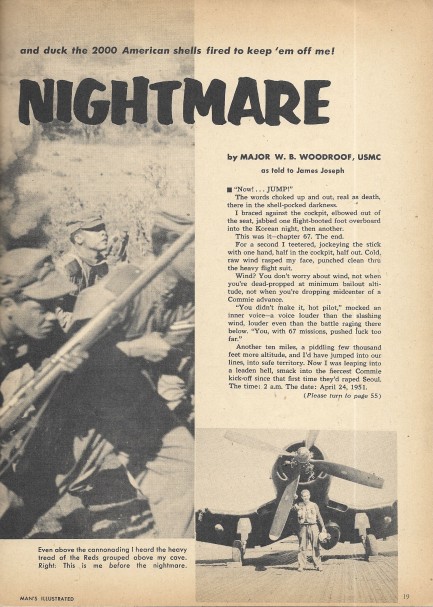 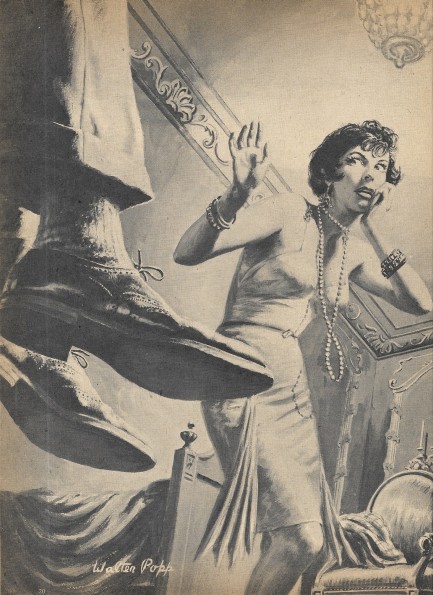 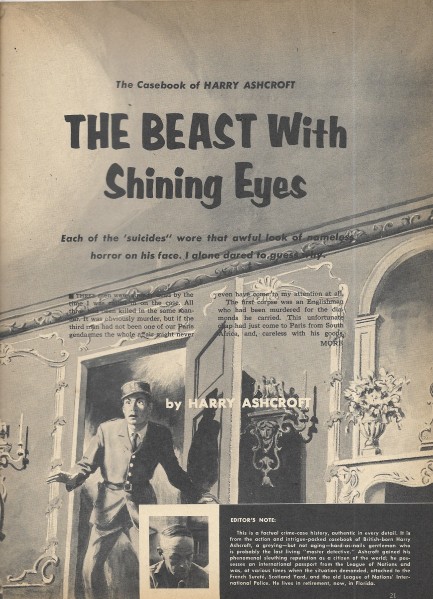 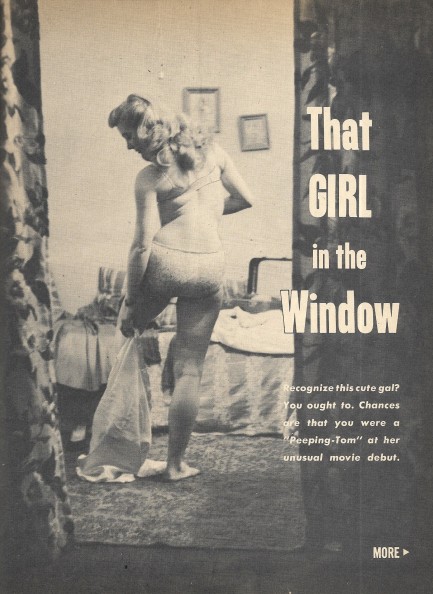 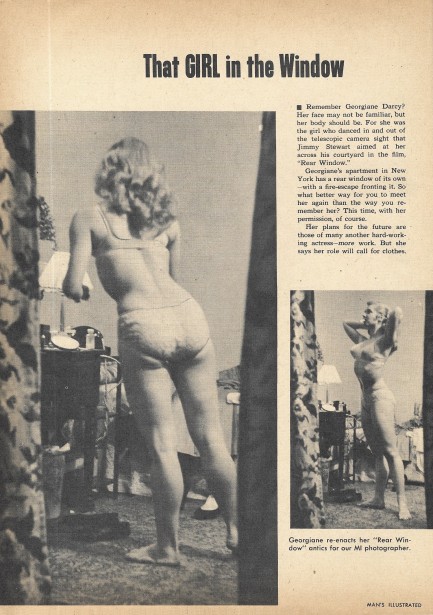 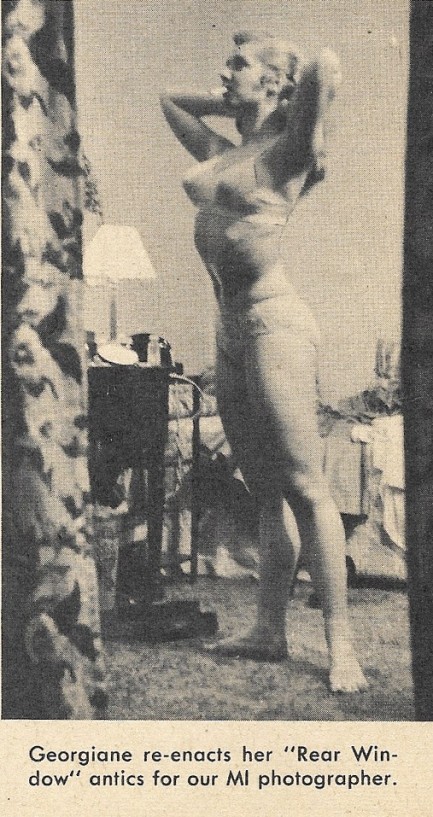 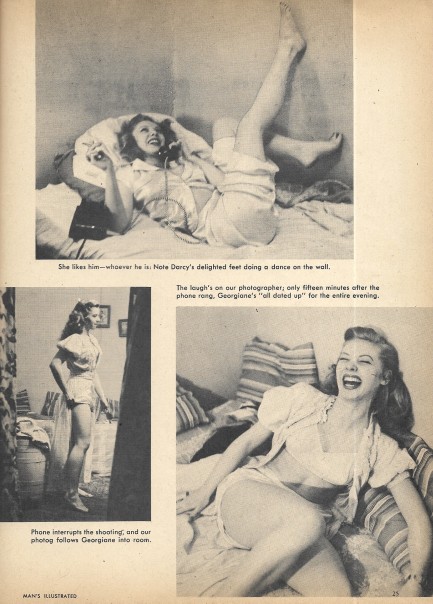 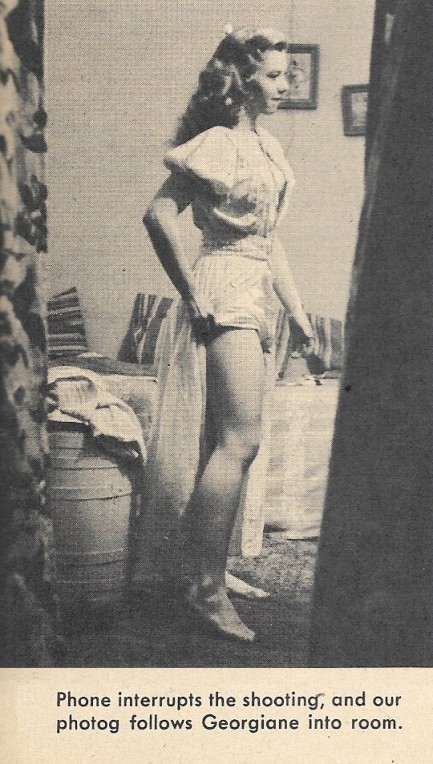 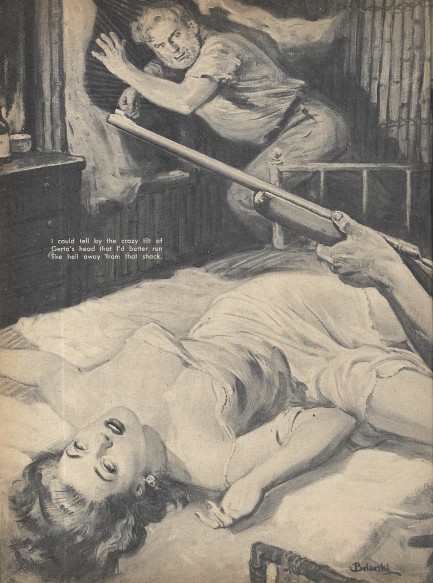 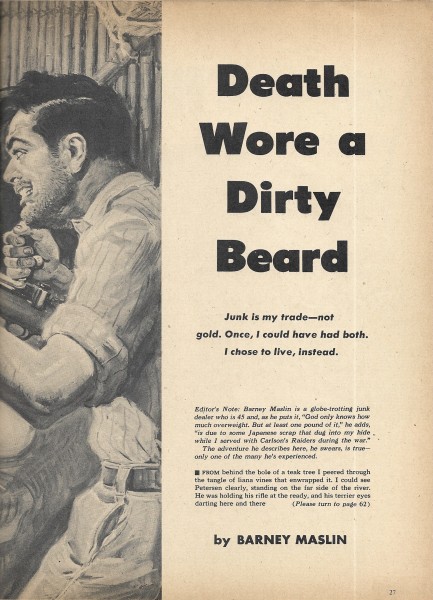 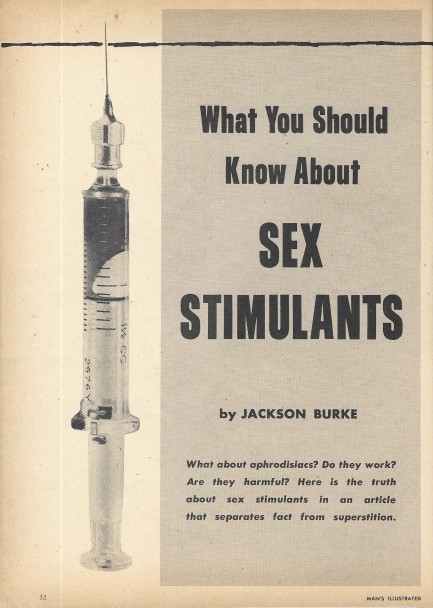 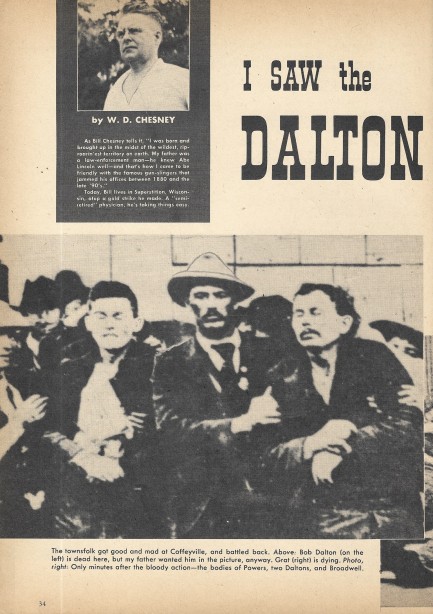 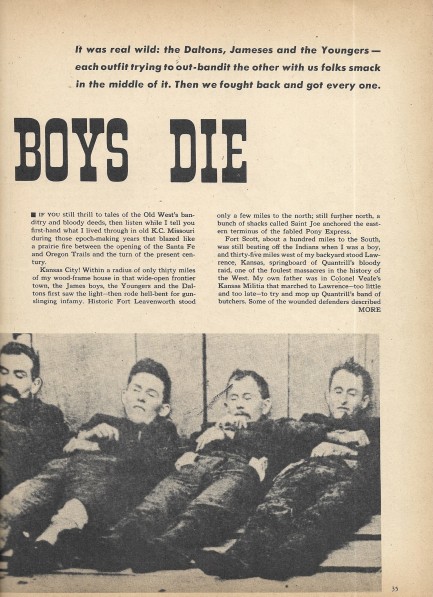 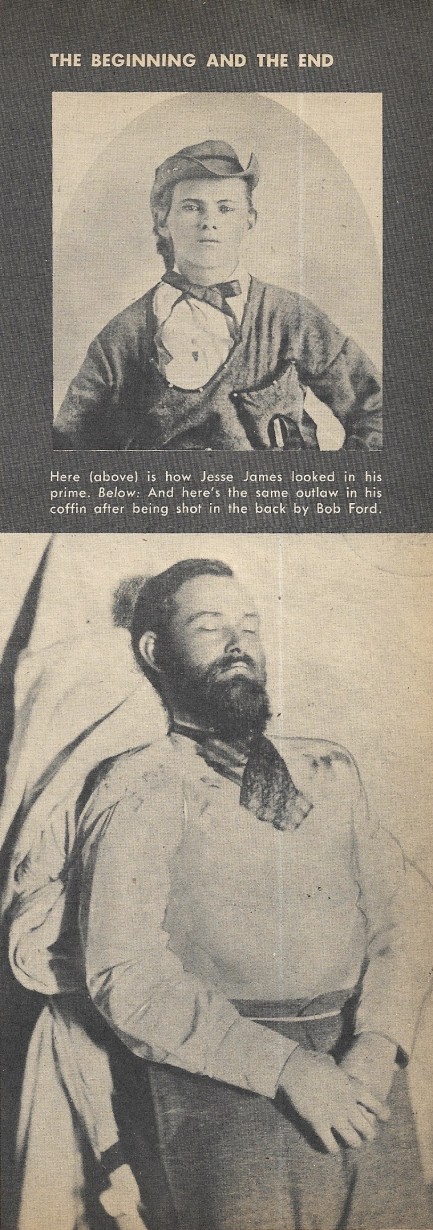 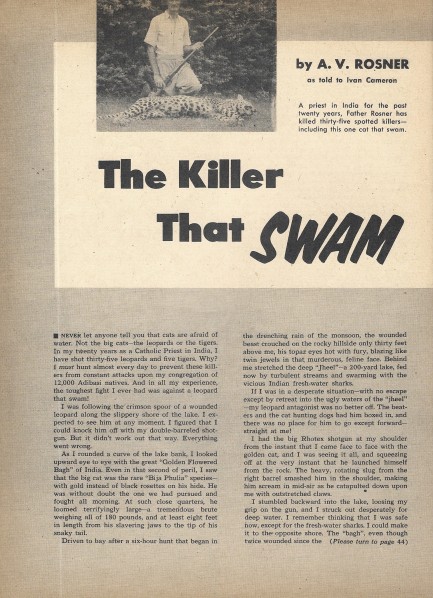 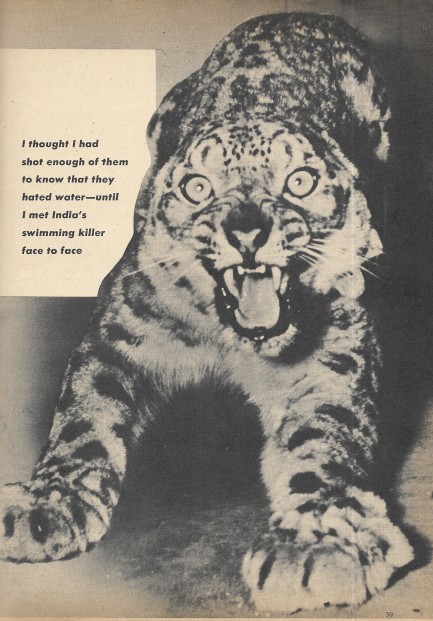 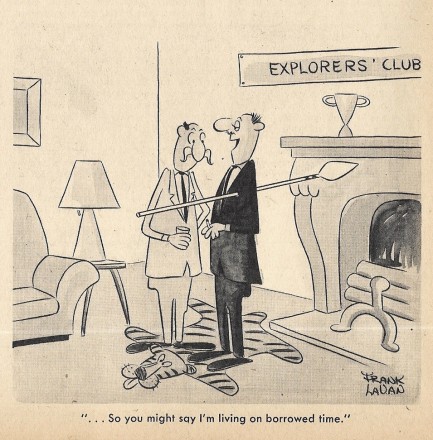
 The list of sensory superlatives quickly runs short. 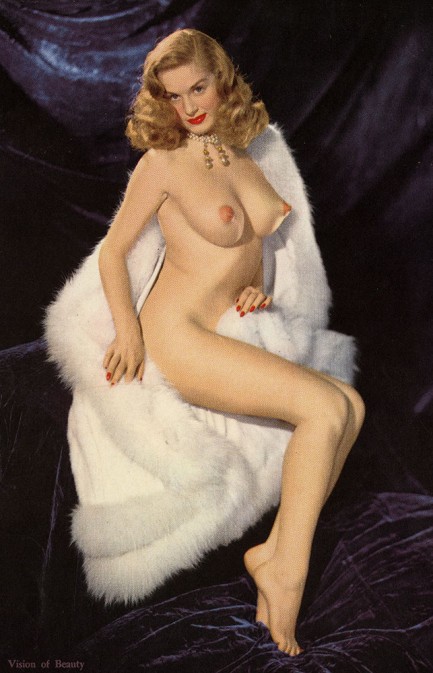
Here yet again is Marilyn Waltz, also known as Margaret Scott, an early Playboy centerfold and popular pin-up model we've featured a few times. This Technicolor lithograph, entitled “Visions of Beauty,” is from 1952, and as you can see below more than one image of her posing against this velvet backdrop was published. The litho below was entitled “Lovely as a Rose.” Like many women who posed nude back then, Waltz had Hollywood aspirations, but her entire cinematic output consisted of a single role in the 1954 b-flick Love Me Madly, aka Love My Way, aka The Wild Sex. The film is forgotten, if not lost, but it's notable—for us anyway—because her co-star was Georgine Darcy, perhaps better known as Miss Torso from Alfred Hitchcock's Rear Window. With Waltz and Darcy on the same set the filmmakers probably needed a fire brigade on standby in case the sound stage burst into flames. You can see everything we have on Waltz by clicking her keywords below. 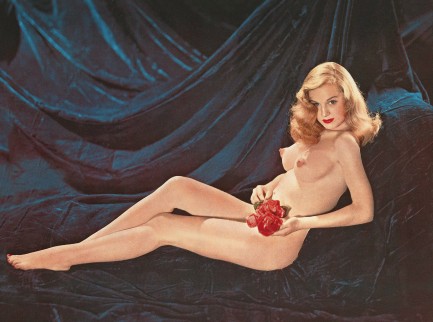 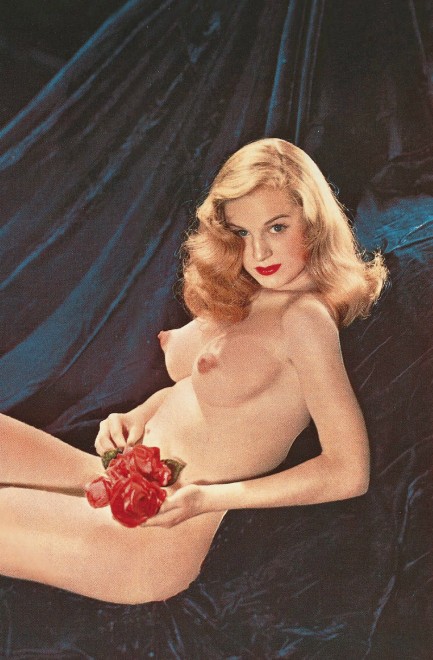 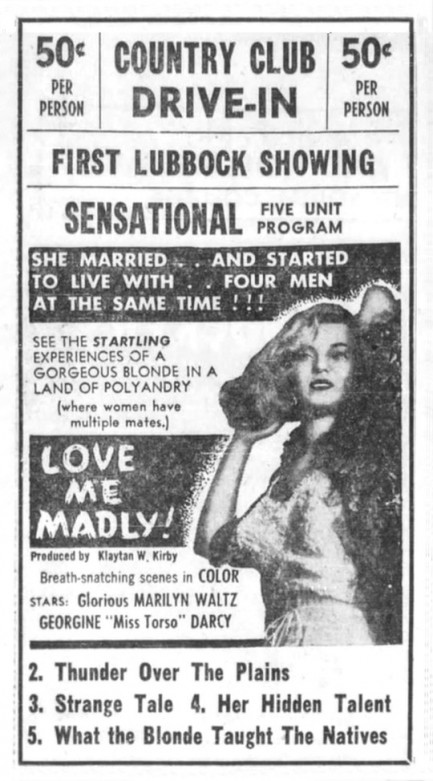

|
 |

The headlines that mattered yesteryear.
2003—Hope Dies
Film legend Bob Hope dies of pneumonia two months after celebrating his 100th birthday. 1945—Churchill Given the Sack
In spite of admiring Winston Churchill as a great wartime leader, Britons elect
Clement Attlee the nation's new prime minister in a sweeping victory for the Labour Party over the Conservatives. 1952—Evita Peron Dies
Eva Duarte de Peron, aka Evita, wife of the president of the Argentine Republic, dies from cancer at age 33. Evita had brought the working classes into a position of political power never witnessed before, but was hated by the nation's powerful military class. She is lain to rest in Milan, Italy in a secret grave under a nun's name, but is eventually returned to Argentina for reburial beside her husband in 1974. 1943—Mussolini Calls It Quits
Italian dictator Benito Mussolini steps down as head of the armed forces and the government. It soon becomes clear that Il Duce did not relinquish power voluntarily, but was forced to resign after former Fascist colleagues turned against him. He is later installed by Germany as leader of the Italian Social Republic in the north of the country, but is killed by partisans in 1945.
|

|
|

It's easy. We have an uploader that makes it a snap. Use it to submit your art, text, header, and subhead. Your post can be funny, serious, or anything in between, as long as it's vintage pulp. You'll get a byline and experience the fleeting pride of free authorship. We'll edit your post for typos, but the rest is up to you. Click here to give us your best shot.

|
|









 One day there will be no more Charles Williams for us to read, and that'll be sad, but his books, like good wine, are something you have to treat yourself to regularly even as the stock dwindles. His 1958 novel All the Way, which is the source material for the 1960 movie The 3rd Voice, is typically solid Williams work.
One day there will be no more Charles Williams for us to read, and that'll be sad, but his books, like good wine, are something you have to treat yourself to regularly even as the stock dwindles. His 1958 novel All the Way, which is the source material for the 1960 movie The 3rd Voice, is typically solid Williams work.






